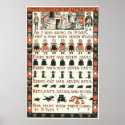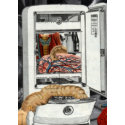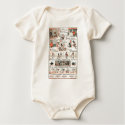A bookcase toppled in our house *sigh*, so until I get that bookshelf replaced, my scanner remains inaccessible due to stacks of books. But don't worry, I'll get to that scanner yet! Meanwhile...
At that last estate sale I helped my parents with there were a number of old bottles. Old dirty bottles. Even long after the house was built, in the early 1970s, the owners would do some gardening and find old glass bottles in the ground. Apparently, they had built on land that previously had been the old farmhouse dumping ground. Some of these bottles had been in the ground for 100 years! While the family had rescued the bottles from the earth, they had simply put them in the garage or potting shed. As is. Meaning they all needed to be cleaned.
Cleaning the bottles is relatively easy. After all, these were not filled with "unknown gunk", but with dirt. And, sad to say, a number of dead mice. Ack! (One may have been a frog; but I couldn't bear to look at it long enough.)
To safely clean old antique glass and vintage bottles (without paper labels) found in the dirt, here's what you do -- but remember, always handle these old bottles carefully, looking for any chips and cracks in the glass or parts of broken metal lids that could be dangerous.

Step One: Soak them in warm soapy water. Any dish washing detergent will do.
Step Two: Pour the dirty water out of the bottles and rinse them a bit. Use a tweezers to pull out larger chunks of dirt and debris (including the little dead bodies of mice *shiver*) and to pull off any rusty remnants of bottle caps or lids.
You'll probably need to scrub some areas. I recommend using a toothbrush. Not only do the bristles get under edges where bottle caps and other lids were, but it is narrow enough to get inside most of the openings so you can scrub a bit of the inside of the bottles as well. You won't be able to reach all the dirt this way, but some sometimes that loosens enough that soaking a bit longer will get the rest out.
If not, you'll probably need to get a tub full of fresh warm sudsy water and try a new approach.
Step Three: Fill a bottle about half-way full of warm sudsy water. Cover the opening of the bottle with your hand, and shake. The agitation of the water will jar a lot of the dirt loose.
If that doesn't get enough of the dirt out, cut a small piece of
Brillo or
steel wool scrubbing pad and again, with your hand over the mouth of the bottle, shake. This time, the steel wool does the scrubbing and scraping. You'll need to turn the bottle in different positions to focus the scrubbing on specific areas, but eventually, you'll get all the dirt out.
Step Four: Disinfect the bottles using a mixture of bleach and water (I like to use 1/4 cup of
Clorox bleach per one gallon of water). Let the bottles soak in the bleach water for at least five minutes to ensure they are disinfected. Then rinse.
Step Five: Let the bottles dry.
Step Six: Now that the bottles are dry, inspect them. Those that have dangerous chips should be tossed (unless you have another
project in mind for those --
more here). But those with brown rust spots, white mineral deposits, etc. can still be saved by using
CLR, Calcium, Rust and Lime Remover.
Make a mixture, equal parts water and CLR. Fill a bottle about half way with the liquid mixture and, covering the opening of the bottle with a
gloved hand, shake as you did with the water. Tip the bottle as needed so as to ensure that the whole bottle, especially the spotted parts, are covered in the CLR mixture. Using a sponge, apply some of the CLR mixture to the outside of the bottle as well. Feel free to use your old friend, Mr. Toothbrush, to scrub some areas as needed. (Just be sure to properly clean the toothbrush afterwards, so no chemicals remain on it!)
Rinse thoroughly in cold water after about two minutes. Reapply and repeat as necessary. You may also wish to let the bottles dry before trying the mixture again, to see how they really look.
Most of the bottles will be clean enough to display. However, some will be too cloudy, etched, and damaged to be in collectible conditions. Since Halloween is almost here, I turned most of those not-good-enough bottles into
spirit bottles!
























